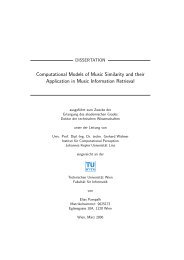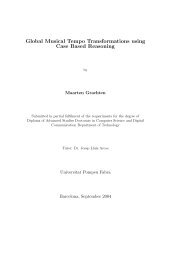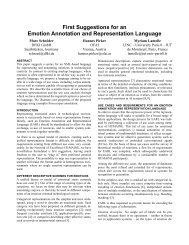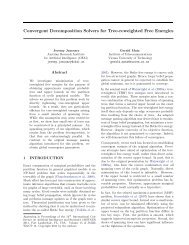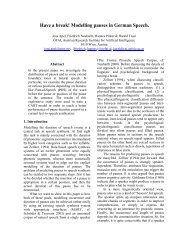A HYBRID MODEL OF REASONING BY ANALOGY
A HYBRID MODEL OF REASONING BY ANALOGY
A HYBRID MODEL OF REASONING BY ANALOGY
Create successful ePaper yourself
Turn your PDF publications into a flip-book with our unique Google optimized e-Paper software.
So two main difficulties have been encountered in human problem solving in this case: (1) recalling<br />
the "immersion heater situation" and (2) retrieving an object corresponding to the immersion heater<br />
in the target situation. It is obvious that both difficulties concern the retrieval mechanism, and the<br />
model has to explain them.<br />
2.2. Priming Effects on Reasoning (Problem Solving)<br />
In the experiment discussed above, since the "immersion heater situation" is well known to the<br />
subjects from their experience before the experiment, the hint condition results in only ignoring the<br />
retrieval process and immediately starting to seek a correspondence between the cases. In contrast<br />
to that, a priming condition would still rely on spontaneous retrieval of the "immersion heater<br />
situation" and noticing the similarities, but in addition to that the subjects' preliminary settings<br />
would be changed so that they could retrieve that source more easily. This is achieved by<br />
stimulating (activating) the source before presenting the target problem and in this way increasing<br />
its accessibility.<br />
It must be noted that most priming effect experiments are performed with low-level tasks like items<br />
recognition, lexical decision, word completion, etc. while Kokinov (1990) has explored the<br />
existence of priming effects in problem solving. The following reviews only part of these results<br />
(concerning only analogy) combined with the results obtained from some additional and more<br />
recent experimental sessions.<br />
Subjects have to solve a number of diverse problems including mathematical, physical and<br />
common-sense ones in a mixed order. One of these problems is the target "wooden vessel<br />
problem" and another (prior to that one) is the priming problem: "How can you make tea in a<br />
glass". There are 3 different priming conditions: (1) the near priming condition where the priming<br />
problem is presented immediately before the target one, (2) the far priming condition where a<br />
single distractor problem (with a limit of 4 minutes for solving it) is given to the subjects between<br />
the priming and the target problems, and (3) the very far priming condition where there are 8<br />
distractor problems (24 minutes) between the priming and the target ones. The priming effect is<br />
measured by the success/failure ratio rather than by reaction time because with such high-level<br />
tasks (as is problem solving) the reaction time depends on too many factors, it is difficult to<br />
measure and is therefore an unreliable parameter.<br />
><br />
The results are shown in Table 2 and the differences between the four groups of subjects are found<br />
to be statistically significant applying the chi-square criterion. In this way it is demonstrated that 1)<br />
there is a clear priming effect on analogical problem solving, 2) this effect decreases in the course<br />
of time, 3) it lasts for a certain period (at least 4 minutes) and, finally, 4) it disappears in less than<br />
24 minutes. This can be illustrated by Figure 1.<br />
><br />
All these results are to be explained by the model.




